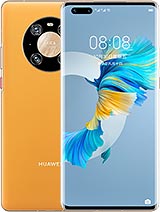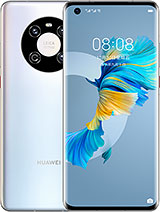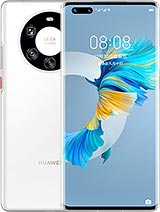Huawei Mate 40 Pro - After 1 Month By SuperSaf
- What's up, guys? Saf here on SuperSaf TV. And today, we're going to be talking about Huawei Mate 40 Pro. Big thanks to Huawei for partnering with me on this video. And we'll also be taking a look at the Huawei FreeBuds Pro and how they work together with the Mate 40 Pro in Huawei's ecosystem. Now, I've had the Mate 40 Pro for around 1 1/2, almost 2 months now. It's kind of hard to keep track of time with the lockdown.
And there's a lot to talk about including the whole software situation, and we will be touching on that a little bit later. But before we do that, let's just pause for a second and appreciate the device itself, right? The hardware, in my opinion, is very much on point. The design is very unique. We've got so many smartphones this year, but when we do put them side by side, I think the Mate 40 Pro really does stand out because of this Space Ring design. Now Huawei have kind of talked about the inspiration behind it, including the picture of the black hole, but let's not go that deep.
But anyway, the thing for me really that strikes out about the Mate 40 Pro is the symmetry, right? So generally, smartphones have a camera module on one side or another. I really like that the Mate 40 Pro has that Mate DNA and everything is symmetrical, and I really do like this design. The Mate 40 Pro does come in two versions; we've got a glossy Black, and then we've got this matte finish Mystic Silver. For me personally, it's an easy choice, it's the Mystic Silver. I really like the two-tone... Well, it's not even two-tone, it's like multiple-tone finish depending on the angle that the light hits it, you get a very different look, and I absolutely love that.
And the fact that this has the matte finish, it doesn't attract as many fingerprints as the glossy version would do. So personally, I'm glad I went with the Mystic Silver. Now being a premium Huawei flagship device, we do have premium materials across the board. So we've got a glass front and back. We've got a metal frame, and this is IP68 water and dust resistant.
Now let's take a look at the display. So this is what Huawei call a Horizon Display, and that's because we have 88-degree angle curves on either side, so these are very extreme curves, and they look absolutely awesome, especially when you're scrolling, everything kind of just melts in to the edges. Now, personally speaking, I am somebody who prefers a flat display, but the Mate 40 Pro, I've not really had any palm rejection issues or anything like that. I think even though the curves are extreme, they do look really good and are somewhat practical. Apart from that, this is a very nice display.
It's an OLED display with a 90-hertz refresh rate. Now it's not 120 hertz like we've got on lots of other smart phones out there, but here's the thing, a lot of other smart phones that have a 120-hertz display, you can only have 120 hertz when you are at 1080p resolution. The Mate 40 Pro has a 1344p resolution, so it's almost Quad-HD, but it's definitely much higher than Full HD. And then you've got that with 90 hertz, so it kind of seems to me like Huawei have gone for a bit of a balance, so that way, you are getting a higher resolution with 90 hertz, and things are very, very smooth, especially because we've got a 240 hertz touch sampling rate. So everything feels super smooth and responsive.
And when we do take a look at the display front on, it actually looks like there are no bezels on the left and right, and that is thanks to those curves. Now we've got small bezels on the top and bottom, so we do have a maximum screen to body ratio, but there is this pill-shaped cutout. Now granted that the pill-shaped cutout does take up some space, but in my opinion, it's totally worth it, and that's because of what we actually have within this cutout. So firstly, we do have an in-display fingerprint scanner, which is very fast and responsive, but then within the cutout, we do have 3D facial unlock sensors. So not only do we have the fingerprint scanner along with the 3D face unlock, you actually have two options.
So generally when I'm at home, I'll just use the 3D face unlock, which as you can see, works very, very fast. But then, when I'm out and about in the day and age of masks, it's actually nice to have the option of the in-display fingerprint scanner. So it kind of covers the best of both worlds. There's other devices which do use just the front-facing camera for facial unlock, but obviously, that's not secure. This is actually 3D facial unlock.
So that's the first thing that we get, thanks to that punch out. But then we've got the front-facing cameras. So you might have already heard me say that the Huawei P40 Pro has my favorite selfie camera of the year, I think the Mate 40 Pro might just have beaten that. And that's because this has an Ultra Vision camera, which has multiple different angles of view. So you can actually switch between around 78 degrees, 90 degrees, and you can have all the way up to 100 degrees.
So if you are taking some group selfies, it's going to allow you to get in a lot more from the front-facing camera, so having those options there is really, really good. But on top of that, you have a 3D depth-sensing camera. Now you may have had lots of other people say that having a depth camera is not useful, and I completely disagree with this because just take a look at some of these portrait selfies. Look at the edge of detection and how good it is, especially in this selfie where I'm actually doing a peace sign. It's also cut around my fingers precisely, and this is something that I really like about the Mate 40 Pro.
As I did like about the P40 Pro, portrait selfies on here are absolutely great. This punch out is larger than others that you may have seen, in my opinion, for all of the additional features that it offers, it's absolutely worth it. Now let's take a look at the rear-facing cameras which are within this space ring design. So we've got a primary camera, we've got ultra-wide camera, as well as a periscope zoom camera. The primary camera is a super sensing camera.
I think the most important thing about the primary camera is its sensor size. It's round 1/1.28 inches, which makes this one of the largest sensor sizes on a smartphone. It's similar to what we had on the P40 Pro and the results are also very good like we had on the P40 Pro. Lots of detail, accurate colors, and you also get a very natural depth of field, thanks to that larger sensor size. And this is also an RYYB camera, so it's not using the red, green, and blue that we normally see on smartphones.
This basically allows in a lot more light, so low-light photography, of course, an area that Huawei has been ahead in for many years now, and again, on the Mate 40 Pro, you get some excellent low light shots too. We've then got the ultra-wide camera. Now, Huawei call this the Ultra Wide Cine Camera, and this allows you to get more into your shots. Now, personally speaking, I would have preferred if this was a little bit wider. I have tested other smartphones that do have a wider field of view, which I do like.
However, Huawei call this a Cine Camera because it is the default camera that you go to when you go into video mode, and this is an area that Huawei has really also concentrated on when it comes to the Mate 40 Pro. So we do have 4k 60 frames a second from all of the cameras, and we have real time hardware HDR, so you get some really impressive results in the highlight and the shadow areas. Then we've got the periscope zoom camera, which is going to give you 5x optical zoom. Now you can see a few examples here at 5x, and then even when you go to 10x, you get some really, really good results. I mean, take this one for example.
I would never be able to physically get this close, so having that 10x zoom, which uses a hybrid of optical and digital zoom, does get you some very impressive and usable results. Now this can go up to 50x. You guys know how I feel about 50x zoom on a smartphone. It works and you can actually get some pretty good results as you can see here, but they're not going to be images that you're going to share on Instagram. It's merely if you do want to kind of see something at a distance.
Maybe there's a sign or something that you want to see at a distance, it's going to allow you to do that. Personally speaking, I tend to stick to around 5 or 10x, and that's where you're going to get the best results, some of the best in this category. Now let's talk about the performance of the Mate 40 Pro. So this is powered by the Kirin 9000 chipset, and I mean, as expected, it's absolutely fine. I'm not somebody who does benchmarks and things like that.
In terms of day-to-day usage, gaming, it's been super fast and snappy. And thanks to the 240 hertz touch sampling rate as well as the 90 hertz refresh rate, things are very smooth and responsive. Now this is an integrated chipset. So this was the world's first 5-nanometer chipset that has integrated 5G. And what that actually means is efficiency, right? Huawei devices, you've heard it many, many times before, are great when it comes to battery life and that's in part thanks to the software, which does do a really good job of putting things to sleep in the background.
But now that we have integrated 5G, it just makes things that much better, and the Mate 40 Pro has excellent battery life. I've not been able to kill this thing, and on top of that, you do have 66-watt charging out of the box. So this is included with the device and this just gives you super, super fast top-ups. As well as that, you do have wireless charging as well as reverse wireless charging. But more importantly, the wireless charging is at 50 watts.
Now I don't actually have a 50-watt charger, but realistically speaking, I've not really needed one because generally, this is going to last me the full day. I can just drop it on a regular wireless charger, I wake up to it fully charged, but just having all of those super-fast charging options there is really, really nice to have. Right, now, we've talked a lot about the hardware and the experience of using this, and I think it's easy to say that this, so far, is one of the best smartphones of 2020, and it ticks off pretty much all the boxes. Now let's talk about software. So the software situation, as you probably already know, unfortunately, is not perfect.
But I've said this before, it is totally workable. So we do have EMUI 11 with the Huawei AppGallery and Petal Search. So Huawei has been working very, very hard to bring as many apps as possible to the Huawei AppGallery. And the apps that you don't have in the AppGallery, you can use Petal Search to find the official APKs for those apps and install them right away. So for example, WhatsApp is an app that is not currently on the Huawei AppGallery.
So if I do search for this on Petal Search, it's going to bring up the official APK from the WhatsApp website, which I can then download and install. So it's pretty straightforward and easy to get a lot of the apps that are not on the web AppGallery as yet. But generally speaking, I tend to use Phone Clone. Now Phone Clone is an app that's very easy to use. You just have to install it on your previous device, scan a QR code, and then it's going to wirelessly transfer all of the apps that are compatible from your previous device on to the Mate 40 Pro.
And there, you'll see there's lot of apps such as Facebook, Twitter, Instagram, will all come over nice and easily from your previous device. But what about Google Play Services? Now, obviously, this is the area where it's a little bit tricky. What you can do is pretty much all of the Google services, such as Gmail, YouTube, you can access via the browser. Now this is not the perfect solution, of course, but having the browser there means that you'll still be able to watch YouTube videos as you normally do. You'll still be able to get them at the resolution you want.
You'll also be able to play around with the speed. I generally watch everything at two times nowadays because my attention span is so, so low. So again, I think it comes down to the fact that, yes, it's not a perfect situation, but if you do want to take advantage of everything that the Mate 40 Pro has to offer, then you can do some workarounds and still get a really good user experience. And speaking of user experience, if you are somebody that owns other Huawei devices, you'll really enjoy the experience that you get on the Mate 40 Pro because everything is connected together seamlessly. It's something that Huawei refer to as 1+8+N.
The 1 being your smartphone, the super controller, which interacts with 8 categories of devices, including PCs, tablets, ear phones, smartwatches, and many more, and the N layer is where everything comes together. Now, I've actually covered the Huawei ecosystem in a lot more detail in a previous video. I'll link that video in the cards and down in the description. But just to kind of show you some examples of how well-integrated Huawei products are with each other, I've got the Huawei FreeBuds Pro. So the FreeBuds Pro are some of the latest noise-canceling earphones from Huawei that feature up to 40-dB noise cancellation depth, a large 11-millimeter dynamic driver, and up to 30 hours of battery life.
And if I bring the FreeBuds Pro close by and pop open the case, you'll see this quick animation which will allow us to connect the FreeBuds Pro to the Mate 40 Pro right away. But of course, it doesn't stop there. You can actually use the mics on the FreeBuds Pro to record audio when filming on the Mate 40 Pro. So for instance, if you're in a loud environment, maybe you want to mount your Mate 40 Pro somewhere and go a little bit distant, you still be able to get clean audio that will be recorded and transmitted wirelessly to the Mate 40 Pro from your FreeBuds Pro. Quick test, just speaking from around 10 meters away.
So I'm roughly about 10 meters away from the Huawei Mate 40 Pro, and I do have my FreeBuds Pro, and the audio is coming through the FreeBuds Pro now. Another example is, say, you have a Huawei MateBook laptop, and you have the FreeBuds Pro connected to the laptop and you're listening to the music, watching a movie, and then you get a call on your Mate 40 Pro, if you answer it, then the FreeBuds Pro will automatically switch from the MateBook to the Mate 40 Pro, making things super seamless and easy. Once again, if you want to know more about the Huawei ecosystem and things like Multi-screen Collaboration, which is personally my favorite feature, I have covered that in that previous video, which I'll link in the cards and in the description. So that is Huawei Mate 40 Pro. Who is it for? Well, as mentioned, it does tick pretty much all boxes when it comes to the hardware, the battery life, the display, the cameras.
The thing you are going to have to consider is the software. If you want to take advantage of everything that the Mate 40 Pro has to offer, including the integration with the Huawei ecosystem, especially if you own other Huawei products, and you can live without direct Google Play services, you don't mind a few of these workarounds and using the browser, then the Mate 40 Pro is a great option, and I can definitely recommend it. What do you guys think of the Huawei Mate 40 Pro? Do let me know in the comments below. I hope you enjoyed this video and found it useful. If you did, then do hit that thumbs up button for me.
And if you haven't already, then be sure to subscribe and hit that bell icon so you don't miss any future coverage. Thanks for watching. This is Saf on SuperSaf TV, and I'll see you next time. (upbeat music).
Source : SuperSaf



























